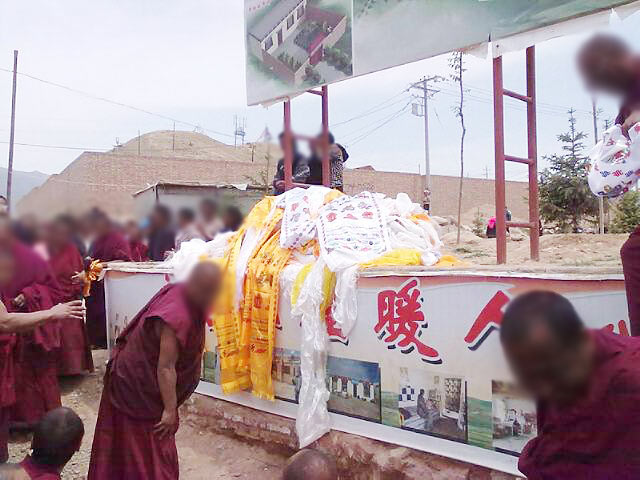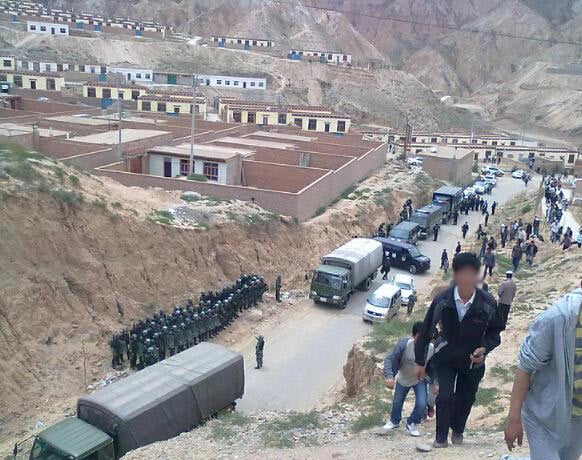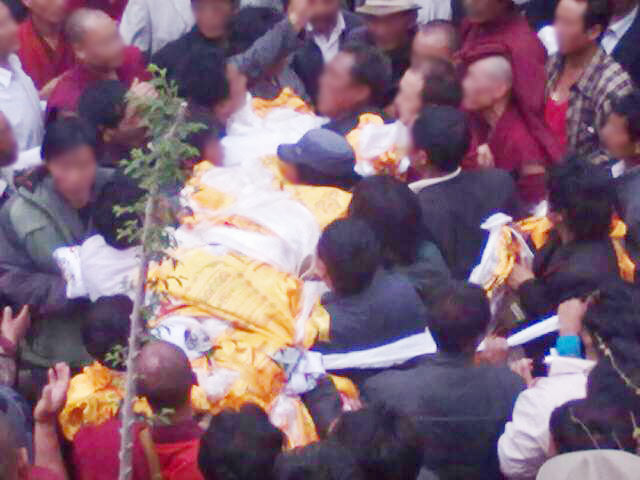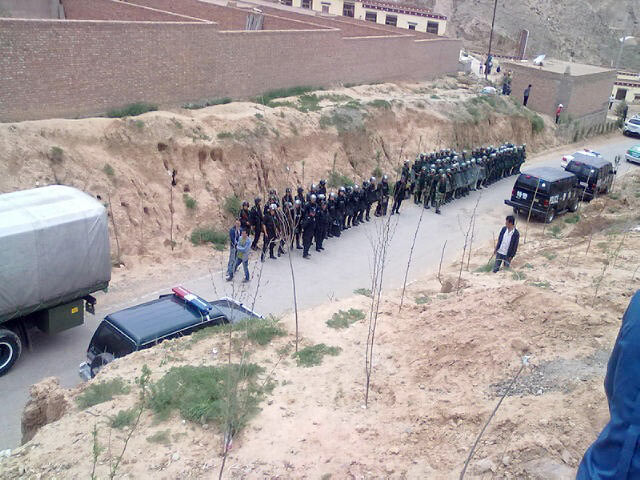- Tibetans gather for the cremation of Tamdin Thar, a Tibetan from a nomad family, who set himself on fire in Chentsa, Qinghai (the Tibetan area of Amdo) on June 15, 2012.
- The self-immolation was confirmed in Chinese state media.
- Tamdin Thar was the 39th Tibetan to have self-immolated since February 27, 2009 (view self-immolation fact sheet).
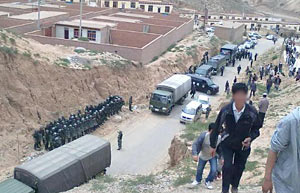
Armed police gather in Chentsa following a self-immolation on June 15, 2012. More photos below.
UPDATE JUNE 15: A senior Tibetan religious teacher who is now living in India told Voice of America Tibetan service today that in recent months Tamdin Thar had made a pilgrimage through the Golog (Chinese: Guoluo) and Ngaba (Chinese: Aba) areas of Amdo (Qinghai), visiting the sites of earlier self-immolations since February 2009. Speaking to VOA in Tibetan, Buddhist scholar Geshe Lobsang Nyandak said that when Tamdin Thar returned to Chentsa he visited his young relative in school and told him to “study hard and be good”. Geshe Lobsang Nyandak, who is originally from Chentsa, said that Tamdin Thar had empathized with those Tibetans who had self-immolated. He added that more troops are arriving in Chentsa, roads to the town are blocked with checkpoints, and school children are confined to the school grounds for the weekend.
Tibetan writer Woeser posted on her microblog a harrowing picture of Tamdin Thar after his self-immolation, and also an image of what appears to be a shrine with burning candles afterwards. The sign on the wall reads: Qinghai Province Jianza County Department of People’s Armed Police.
Tibetans in eastern Tibet gathered today to mark the self-immolation of a Tibetan from a nomadic family who set fire to himself and died in Chentsa (Chinese: Jianza) county town in Qinghai (the eastern Tibetan area of Amdo). Images posted online by Tibetans in exile showed crowds gathering to pile khatags (Tibetan blessing scarves) on the body of Tamdin Thar, who was in his forties or fifties, while massed ranks of armed police gather at the roadside nearby.
Events moved rapidly today after Tamdin Thar set himself on fire early this morning in front of the People’s Armed Police base in Chentsa, Malho (Chinese: Huangnan) Tibetan Autonomous Prefecture, according to Tibetan sources in exile.
Armed police were seen extinguishing the flames as Tamdin Thar lay on the ground, still moving slightly, and he was then taken away in a vehicle by security forces. According to Tibetan sources in exile in touch with Tibetans in the area, he died within hours, and local people gathered in the town calling for the return of his body, despite an increasing number of armed police being deployed.
The body was returned to local people at around mid-day today, according to various sources. The Chinese state media confirmed the self-immolation and death but did not name Tamdin Thar.
New images from inside Tibet show monks and laypeople converging upon the cremation of Tamdin Thar on a hillside near the town. On the road at the foot of the hill, armed troops and special forces who have arrived in a convoy of vehicles are stationed in riot gear. The images show Tamdin Thar’s body draped in khatags (Tibetan white and yellow blessing scarves). According to Tibetan exile sources, Tibetans from many different villages near Chentsa and monasteries outside Chentsa have converged upon the town to offer prayers for him.
The gathering of so many Tibetans to pay their respects to Tamdin Thar despite the dangers to ordinary Tibetans of an intimidating military presence demonstrates the strength of feeling about the self-immolations and sense of solidarity among Tibetans. Similarly, two weeks ago in Dzamthang, Ngaba (Chinese: Aba), also in Amdo, thousands of Tibetans gathered to pray at the cremation of Rikyo, a Tibetan mother of three young children, who set herself on fire and died on the spot on May 30. Despite a heavy thunderstorm and rain, Tibetans continued to pray following Rikyo’s cremation until the early hours of the morning.
Tamdin Thar came from a nomadic family in Lowa village, Chentsathang Township, Chentsa County in Malho TAP. According to the Tibetan Center for Human Rights and Democracy based in Dharamsala, India, a few years ago Tamdin Thar and his family moved to the county due to the Chinese government policy of relocating nomads off their land. At the time of his self-immolation, Tamdin Thar’s family had been out of town collecting caterpillar fungus (yartse gunba). After the loss of their land and livelihoods, and ill-prepared to compete with Chinese migrant workers for employment, more Tibetans in Tibet depend on collecting the fungus to earn a living.
Tamdin Thar is the 39th Tibetan to set fire to himself in Tibet since February 2009, and the sixth from the Qinghai area. Although his last words are not known, Tibetans in exile who are in contact with people in the area believe that he called for freedom in Tibet and for the Dalai Lama to return home.
People in Malho are fiercely protective of the Tibetan language and culture. It was the site of a major protest in 2008, a students’ protest in 2010, and other public expressions of Tibetan feeling in 2010 and 2011.
Earlier this year, monks at the historic Lamu Dechen monastery in Chentsa, Malho, marked the March 10 anniversary of the 1959 Tibetan Uprising (and the 2008 protests) with a bold and peaceful religious commemoration, and a strict lockdown was imposed by the authorities. Monks at Lamu Dechen created butter sculptures (a traditional form of offering) of the Dalai Lama and also of the Tibetan ‘snow lion’ flag, which is banned in Tibet. The monks and local people were seeking to mark a specific prayer festival, as part of an endeavour to maintain specific local traditions.
On March 10, the day that the Tibetan Uprising of 1959 is commemorated, at least 50 monks from the Lamu Dechen monastery gathered together to burn incense in front of the monastery. According to the same sources, during the gathering, monks called for the Dalai Lama to be allowed to return to Tibet, and for freedom. They began to march towards Chentsa county town, around 25 kilometers away, but were begged to stop by local men and women who feared for their safety. Five military trucks of armed personnel arrived at the monastery soon afterwards (ICT report, Tensions escalate in Qinghai: Rebkong self-immolation, student protest, monks commemorate March 10).
On October 24, 2010, several hundred students and teachers from high schools in Chentsa took to the streets in support of the continued use of Tibetan language in local schools (RFA, Clampdown in Tibetan Schools). The Tibetan writer Woeser, who is based in Beijing, told Radio Free Asia: “It’s not that they are against being taught Mandarin; Mandarin is the main language now. But they are against Tibetan being relegated to second-class status. Perhaps fewer and fewer people in future will speak Tibetan, so the students want to come out in support of Tibetan, and of more rights for the Tibetan language.”
In March, 2008, hundreds of Tibetans protested in Chentsa, carrying photographs of the Dalai Lama and the Panchen Lama, shouting slogans including calls for the release of the 11th Panchen Lama recognised by the Dalai Lama, Gedhun Choekyi Nyima, who has been in Chinese custody since 1995.
The following photos appeared online following the self-immolation of Tamdin Thar on June 15, 2012. The faces have been blurred by ICT.
